The Greek Church
Life under the Islamic Turks continued to be very difficult for the Christians living in the Ottoman Empire. Although some Serbs managed to emigrate to Austria and Hungary where they were allowed to have their own dioceses, this was the darkest hour for those Christians who remained under Turkish control.
Yet this was also a time of renewed hope, as seen in the lives of three very remarkable saints who lived in Greece.
Saint Cosmas Aitolos
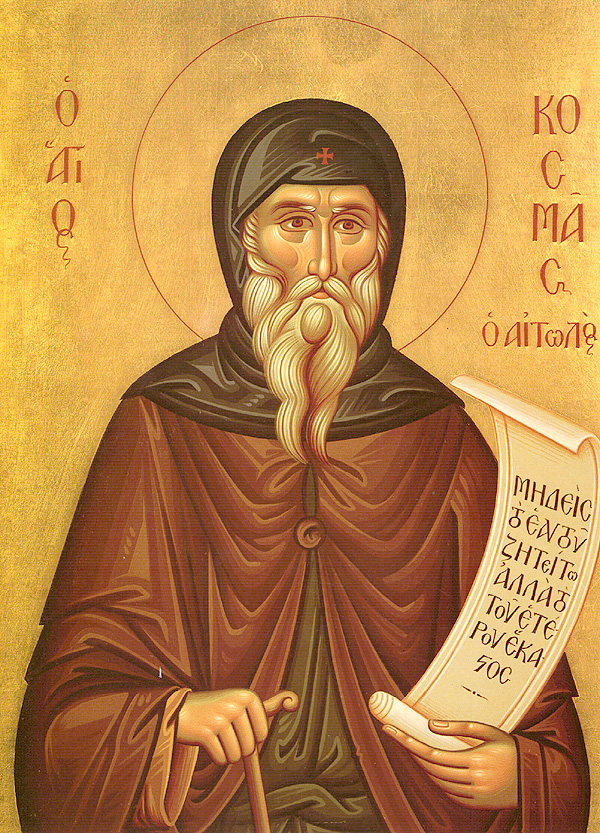
Plus Saint Cosmas Aitolos (1714–1779) has been called Equal-to-the-Apostles, Apostle to the Poor, and Father of the Greek Nation. From a family of poor weavers, and basically self-taught, he lived as a monk on Mount Athos for seventeen years. Then he felt compelled by God to leave the Holy Mountain in order to rally the discouraged Greeks and Albanians suffering now for three hundred years under Turkish oppression, and to strengthen them in their Orthodox Faith.
Receiving the blessing of Patriarch Sophronios II of Constantinople to do this, Saint Cosmas undertook three apostolic journeys as an itinerant preacher throughout central and northern Greece, the Greek Islands, Epiros, and Albania. Sometimes he would be followed by hundreds, even thousands, of villagers.
His life and preaching were marked by great humility. Once he said to the people, “Not only am I not worthy to teach you, but I am not even worthy to kiss your feet, for each of you is worth more than the entire world.” He was not a worker of miracles in the physical realm, but through his love, humility, and exhortation, many broken relationships were miraculously healed.
He instigated the founding of over 200 schools by urging the elders in the various towns and villages to get one started. His promotion of Christian education significantly raised the educational level of all of Greece, which helped sustain the strength of the Orthodox Faith, and helped lay the groundwork for the overthrow of the Turkish yoke in Greece in the 1820s.
Typically he would come into a town or village and say to the gathered crowds, “So, my children, to safeguard your Faith, and the freedom of your homeland, take care to establish without fail a Greek school in which your children will learn all that you are ignorant of.” And again, “My beloved children in Christ, bravely and fearlessly preserve our Holy Faith and the language of our Fathers, because both of these characterize our most beloved homeland, and without them our nation is destroyed. Don’t be discouraged, my brethren; Divine Providence will one day send heavenly salvation to gladden your hearts and eliminate this dreadful state in which we find ourselves.” He prophesied correctly (at least for central and southern Greece) that “freedom will come in the third generation. Your grandchildren will see it.”
Saint Cosmas was highly respected by many of the Turkish people living in Greece, but he was perceived as a political threat by some of the authorities. Executed by the Turks in Berat, Albania, in 1779, he is one of the hundreds of “New Martyrs” for Christ who died at the hands of the Ottomans.
Saint Makarios of Corinth
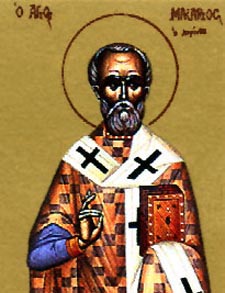
Saint Makarios of Corinth (1731–1805) was of aristocratic background. As a young man he was a volunteer school teacher in Corinth, his birthplace, for six years. Then, though still a layman, he was unanimously selected by laity and clergy to be the new archbishop of Corinth.
As bishop, he immediately began improving the state of the Church under his care by more strictly applying the canons regarding Church life. For instance, he prohibited priests from taking part in political affairs, and he strictly honored the canonical age for clerical ordinations. He distributed catechisms to all his priests, discharged all illiterate priests, and sent ordinands to monasteries for training. He also urged the wealthy to donate large baptismal basins to the churches, so that children could be baptized properly. He planned to establish schools throughout his archbishopric, but was prevented from doing so by the Russo-Turkish War in 1768, which ended his episcopacy in Corinth.
After his episcopacy, he went to live on Mount Athos as a monk. Here he devoted much time to editing and writing. In this way he made great contributions to the life of the Church.
While on Mount Athos, he helped to found the Kollyvades Movement. This was a group of fervent defenders of traditional Orthodoxy. Its formation was in response to the innovation of the Skete of Saint Anne on Mount Athos of holding memorial services for the dead on Sundays—which seemed to the Kollyvades to be a violation of the spirit of Sunday as the day for the celebration every week of the Resurrection of Christ. The Kollyvades (from ‘kollyva,’ the boiled wheat eaten after such memorial services) were first called this derogatorily by the innovators.
The dispute spread to other sketes of the Holy Mountain and assumed dangerous proportions, with the innovators insulting and persecuting the traditionalists. Eventually, after much conflict and indecision, the new practice was accepted by the Patriarchate of Constantinople.
Many of the Kollyvades party also espoused more frequent partaking of Holy Communion, since for centuries it had become very widespread practice that people were communing only two or three times a year. The Kollyvades saw this as symptomatic of the severe decline in the spiritual life of the people in this era. In 1777 St Makarios published a book called Concerning Continual Communion of the Divine Mysteries. In 1783, Saint Nikodemos gave this book its final form. Appealing to the Scriptures, the Fathers, and the canons of the Church, Saint Makarios and Saint Nikodemos in this book specifically refute 13 reasons typically given as to why the Eucharist should be received so infrequently. The book was met with much resistance, before it was finally generally accepted.
The Kollyvades group also revived and cultivated an interest in hesychastic, mystical prayer, which had fallen into relative oblivion. Saints Makarios and Nikodemos helped very much to revive hesychasm in their own day through their publication of the Philokalia—the highly renowned compilation of selected spiritual writings from the 4th through the 15th centuries. In their introduction, the editors say that they have compiled the work from various old manuscripts “found scattered in dark holes and corners.” To this day, the Philokalia is considered among the Orthodox as the greatest anthology of spiritual wisdom ever published.
Some particularly noteworthy writings in the Philokalia
Saint Mark the Ascetic, “On Those who Think that They are Made Righteous by Works” (5th century)
Saint Diodochos of Photiki, “On Spiritual Knowledge and Discrimination” (5th century)
Saint Maximos the Confessor, “Four Hundred Texts on Love” (7th century)
Saint John of Damaskos, “On the Virtues and the Vices” (8th century)
Saint Symeon Metaphrastes, “Paraphrase of the Homilies of St Makarios of Egypt” (11th century)
Nikitas Stethatos, “On the Inner Nature of Things and on the Purification of the Intellect” (11th century)
Saint Peter of Damaskos, “A Treasury of Divine Knowledge” (12th century)
Saint Gregory of Sinai, “On Stillness” (14th century)
Saint Gregory Palamas, “In Defense of Those who Devoutly Practice a Life of Stillness” (14th century)
Makarios went to Smyrna to raise money to publish the Philokalia, along with Concerning Continual Communion and the Evergenitos (a large collection of lives and sayings of the Desert Fathers, which has deeply influenced monastic spirituality). Saints Makarios and Nikodemos also collaborated in compiling The Extant Works of Saint Symeon the New Theologian.
Saint Makarios also contributed to the publication of a new martyrologium, consisting of the Lives of 75 Orthodox new martyrs who suffered under the Ottoman Turks between 1492 and 1794. He played a role in directly encouraging some of the new martyrs through being a father confessor to a number of Greeks who had been converted in one way or another to Islam, but then returned to the Christian Faith and wanted to atone for their apostasy by martyrdom.
Many of the Kollyvades left Mount Athos due to the persecution there. According to Constantine Cavarnos, they “scattered all over Greece, especially the Aegean Islands, becoming spiritual awakeners and reformers through their sermons, personal counsels, the establishment of monasteries that developed into luminous centers of spiritual life, and their exemplary Christian character and way of life.”
Saint Makarios was one of the Kollyvades who left the Holy Mountain, eventually settling in a hermitage on the island of Chios. There he lived in peace from 1790 until his death in 1805.
Saint Nikodemos of the Holy Mountain
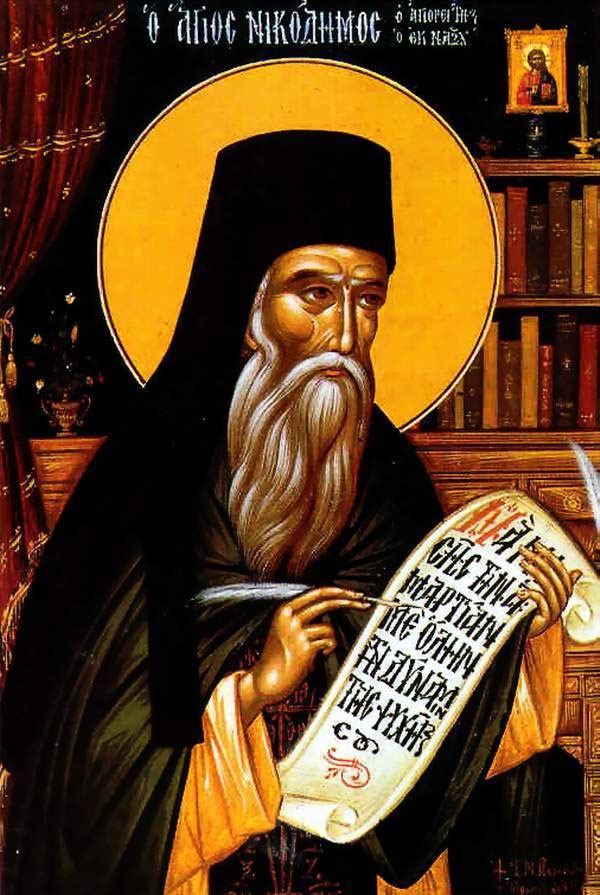
St Nikodemos (1749–1809) was born on Naxos in the Cyclades Islands to pious parents; his mother eventually became a nun. He was wonderfully pious and intellectually brilliant, with a nearly photographic memory. His first teacher was the brother of Saint Cosmas the Aitolian. In 1775 he became a monk on Mount Athos, where he lived at several monasteries and sketes. He even left Athos for a while to live on a small island near Euboea.
Often working together with Saint Makarios of Corinth, Saint Nikodemos devoted most of his life to writing, editing, and translating. His works include a modern Greek translation of the commentaries by Blessed Theophylact of Ochrid on the 14 Epistles of Saint Paul and on the 7 Catholic Epistles; a modern Greek translation of the Psalms, with extended commentary; the Philokalia and Evergenitos, already mentioned; and the works of Saint Symeon the New Theologian, already mentioned. He also edited the works of St Gregory Palamas, but the manuscript, except for the introduction by Nikodemos and a few parts, was lost in Vienna.
Saint Nikodemos also revised a book on spiritual guidance called The Spiritual Exercises, written by a Roman Catholic priest named Lorenzo Scupoli, which he published with the title Unseen Warfare. He also produced The Rudder, a compilation of the canons of the Church, with commentary in demotic (popular) Greek. And as previously mentioned, he revised Saint Makarios’s Concerning Continual Communion. He also wrote many hymnological works, especially akoluthias and canons for saints.
In addition, Saint Nikodemos wrote a book giving guidance to priests for how to be an effective spiritual father, especially through proper use of the Sacrament of Confession. Unfortunately, this book, entitled Exomologetarion, or A Manual of Confession, reflects considerable Roman Catholic influence, as seen in its tendency towards legalism concerning penances to be given for confessed and absolved sins, and in its apparent acceptance of the Anselmian sacrificial theory of atonement, with Christ’s sufferings in bearing the sins of the world on the Cross understood as appeasing the wrath of God the Father against all of fallen mankind engulfed in sin.
Two other important saints of Greece
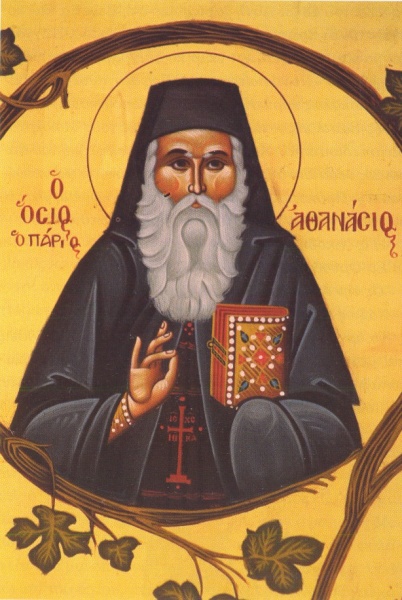
Saint Athanasios Parios (c. 1722–1813), was another leading churchman of this era. A disciple of Saint Makarios, he wrote this saint’s biography. Saint Athanasios was also deeply influenced by the revival of hesychasm. He taught at the Academy on Mount Athos, then in Thessaloniki, then on Chios for 25 years. There he had strong influence on hundreds of Greek youths. He loved to bring forth the wisdom of the great Eastern Fathers of the Church, and he especially tried to revive interest in the works of Saint Gregory Palamas.
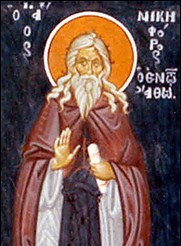
Saint Nikephoros of Chios (1750–1821) was another important Greek saint in this era. He taught at the famous school at Chios for 20 years, until 1802, when he became abbot of the Monastery called Nea Mone on Chios. After Saint Makarios of Corinth died, Saint Nikephoros wrote hymns honoring him.
